Deborah Wiles's Blog
November 28, 2025
Storybelly Digest/Writers Lab
Happy Thanksgiving, Lab Coats (Sweethearts of the Storybelly Lab) and All Storybellers. I’m in a Substack learning phase. Pausing subscriptions until Jan. 5 means… well I’m still trying to figure out what-all it means, but so far it seems that all posts are available to ALL current subscribers for a limited time. So here we are, all together today. I like how y’all look. :>
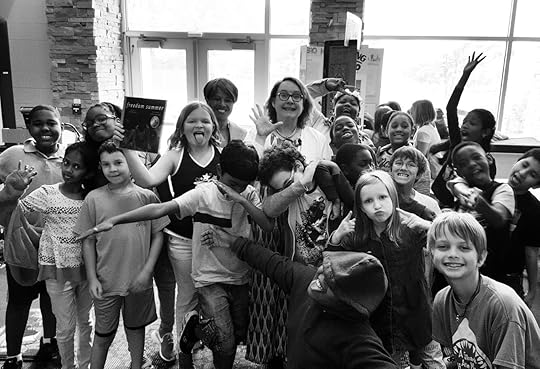 Me & Freedom Summer & a clutch of cool kids at a cool school visit long agoTHE PAUSE:
Me & Freedom Summer & a clutch of cool kids at a cool school visit long agoTHE PAUSE:The subscription pause also seems to mean that Chat is open to all subscribers now as well, for the next five weeks. (We are already a week into our hiatus; time flies.) I’ll continue to post in Chat, and I’m also using Notes (and IG, and probably an occasional post because, evidently, I can’t help myself) as a way to stay in touch through the holiday season and into the new year.
SECOND SUNDAY LIVE:As for our Writers Lab Live on December 14 — as I wrote in Chat — we will welcome Nancy Werlin as our guest! Nancy is a NYT bestselling author, Edgar Award winner, and National Book Award finalist, among many other talents.
She has more than tiptoed into indie/self publishing; she is experienced and very successful with it. She’s going to give us her take on what she sees in the publishing atmosphere these days (as a long-time studier of trends), and a look at how she is publishing her work today. There will be time for Q&A and lots of good conversation.
I’ll send the Google Meet link in an email to the writers who have been building this space together each week in the Lab and in Second Sunday Lives, so our guest steps into the familiar circle we’ve been creating together.
JOIN THE LAB IN JANUARY:This is where I usually post a link to join the Writers Lab, but since all subscriptions are paused during our holiday hiatus, this means (I think) no new Writers Lab subscriptions are processed. Come join us in January when we begin again!
JOIN US NOW IF YOU ARE ALREADY A LAB COAT:However: if you’re a Lab Coat already who hasn’t yet joined the Lives before and you would like to be part of this Live (making your Live debut, so to speak) on the next Second Sunday (Dec. 14 at 11amET), DM or email me so you can join in with this small-but-mighty, curious-and-courageous, warm-and-witty, delightfully intrepid and actively engaged community of wordsmiths. Whew!
LET’S WRITE TOGETHER TOMORROW! (Sunday, Nov. 29)I have a grandgirl and a granddog here this weekend, after a sweet Thanksgiving day at their house yesterday, so a Live will be hard for me to coordinate tomorrow, but since A (our grandgirl) is a teenager now, the mornings are usually pretty open (but not guaranteed). M (our granddoggie) likes to be with people, so she’ll be right by my side, like she is now, but I am still going to write tomorrow morning from this space:
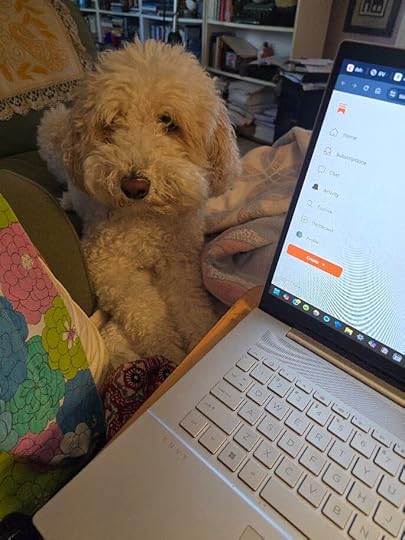 early this morning, me’n’Milly… and you, as I’m writing to you here
early this morning, me’n’Milly… and you, as I’m writing to you hereAND, since all Storybelly posts this next month are available to all subscribers, here is an invitation for ALL OF YOU to write together tomorrow morning!
Not a Live, but a Synergy nonetheless. I’ve written with friends so many times over the years, when one is across the country (or world) and I am here in my house (or elsewhere), and I promise you, if you KNOW you are writing together, you can feel it.
SO LET’S DO THAT.I’m going to write tomorrow morning from whenever I get at this desk (usually early) until I can’t anymore. I’ll post in the comments below when I begin. Then I’m going to put a “results report” in comments later tomorrow.
Let’s create some synergy. It will do the world — and us — some good.
Come early, come late, but come! Write for as long as you want, as short as you must, there are no rules, write whatever you want. Let’s do this.
If you can’t come on Sunday, know I am writing every day this week, every morning. Let me know you’re “in” on any day, and we’ll write together. You can email me, text, DM, put a note in Chat or the comments. Let’s see what happens.
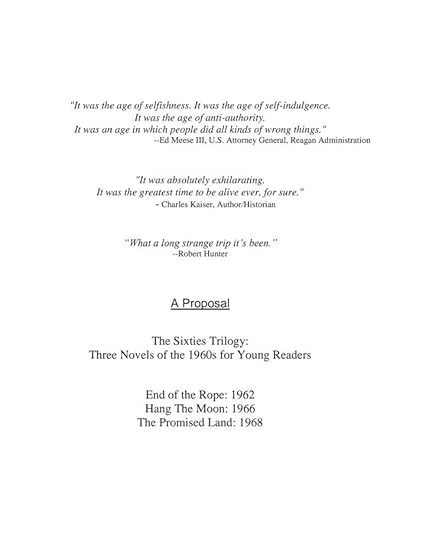 If you’re familiar with the Sixties Trilogy, you’ll know that those titles are not the same titles that ended up on the books. Things change when you sit at the page and commit to your story, whatever it is. Come write with us!
If you’re familiar with the Sixties Trilogy, you’ll know that those titles are not the same titles that ended up on the books. Things change when you sit at the page and commit to your story, whatever it is. Come write with us!
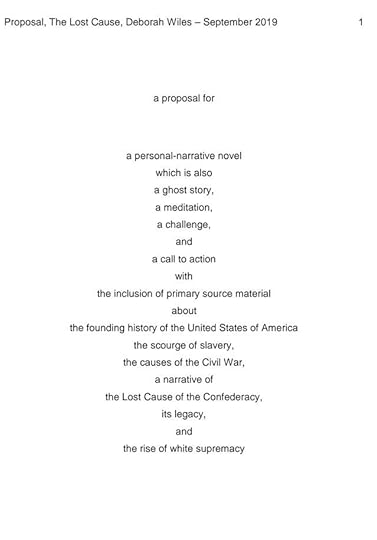 the title has already changed (to Charlottesville), but the rest seems to be about right, although the structure is driving me batty. Something to continue to untangle this week. Come along and do some untangling of your own.
the title has already changed (to Charlottesville), but the rest seems to be about right, although the structure is driving me batty. Something to continue to untangle this week. Come along and do some untangling of your own.
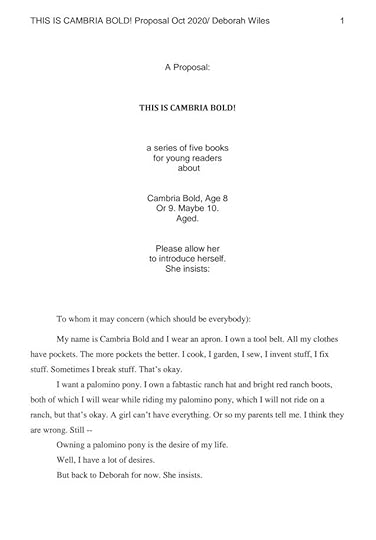 and on a lighter note! I want to work on this, too… something that makes me laugh. You? Let’s work together and create some synergy.WANT A PROMPT?
and on a lighter note! I want to work on this, too… something that makes me laugh. You? Let’s work together and create some synergy.WANT A PROMPT?Here’s a prompt for you to use or toss, it’s totally up to you. The writing is the important thing, whether it’s:
Your First Thanksgiving
poem
essay
fiction
vignette — or whatever… write to this prompt:
(or Any Thanksgiving, or Your First Anything).
Remember what we’ve worked on all year — see previous Lab posts for details. Here’s a partial list:
What is your canon?
Write a Focus Sentence
Give yourself permission to be authentic.
What we write about when we write about our lives
Writing about food, and ancestors, and heroes
The power of using a notebook and ways to use one
The unity of opposites
“It all turns on affection.”
Vision and Mission statements, Core Values and how they shape our writing
Sets of Three
Hooks, Thresholds, and Invitations
Making Dialogue work for you
Writing with telling detail and description
Writing with nouns and verbs
Writing from the inside, out
That’s enough for now — enough to get you started!
WHAT ABOUT OUR 20 PROJECTS POEM?I love me a 20 Projects Poem. There is no way to mess them up. They are good just by definition. I would love to read yours! Here are the directions for writing one, and also in that post you can read my 20 projects poem. Maybe Cathy can encourage us to keep going with those, and can share hers in Chat? If you’re comfortable, of course, friend. I love how you discovered the power of the 20 projects poem to open up your work.
If you like, and you don’t have something else specifically in mind, or you want a boost for what you’re currently working on, you can work on a 20 projects poem in tomorrow’s Synergy Writing Session. (Needs a better name.)
And I have a secret for you: They are FUN.
WHAT ABOUT OUR ZINES?I haven’t forgotten about the friggin’ Zines. :>
They don’t seem to be as much fun.
More on the Zine Project coming up soon, I almost promise.
Meanwhile: HOW ARE YOU DOING WITH YOURS?
Tell me in comments, please. I will reveal my mediocre efforts as well. le big fat SIGH. Maybe Sharon can chime in with some encouragement for “how easy” (please) this accordion method is… if you’re comfortable, too, of course, S.
THAT’S ALL FROM THIS POP-UP POST! Were you surprised? I was. I miss y’all. That is not surprising.See you tomorrow and all next week, writing away — yes? Watch for my comments in… comments. :>
Happy Friday!
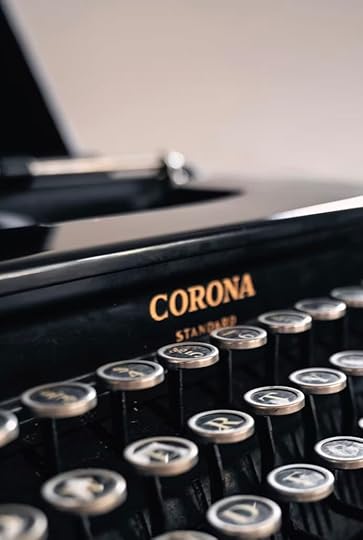
xoxox Debbie
November 21, 2025
Writers Lab: Shifting Into the Messy Glory
Good morning, Lab Coats and all Storybellers today. Here is a Writers Lab for everyone, as we barrel toward Thanksgiving.
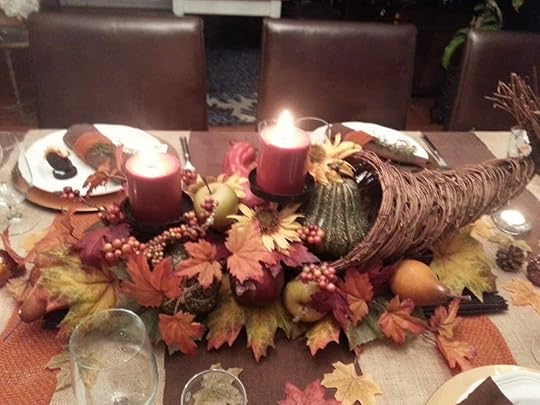 Thanksgiving 2015Some News!
Thanksgiving 2015Some News!Starting today, I’ve paused all paid subscriptions until January 5, so no one will be billed from this date (Nov 21) through Jan. 5. If you are a paid subscriber (i.e. a Lab Coat), you’ll have the next six weeks “paid for” — that is, your subscription is extended by six weeks.
You can enjoy the Storybelly archives to your heart’s content, as well as your cookie baking and tree decorating, menorah lighting, Karamu feasting, temple visiting and midnight bell ringing, song singing, ancestor honoring, tradition fulfilling… and family dramas to the hilt — ha! I’ll be doing the same, enjoying or surviving it all. :>
Storybelly Digest posts and Writers Lab posts will resume in January.
Where I’ll Be:Meanwhile, while scribbling my lofty thoughts and plotting crazy notions in the margins of my work-in-progress, Charlottesville, I’ll continue to be present — here are links to where I’ll be:
Substack Notes (open to everyone),
Writers Lab Chat (a community space for Lab Coats),
DeborahWilesBooks at Instagram where I check in frequently, mostly on IG Stories, which I often save to IG Highlights on that same page.
Come visit any and all of these places and say hey when you’re not up to your eyeballs in life and work and love.
Writers Lab Second Sunday Live! on December 14 at 11atET:Lab Coats — this next is for you — we’ll use CHAT to keep up with your/our various writing projects including the Zine, the 20 Projects Poem, and weekly writing suggestions. Also, we WILL be doing our Live! on December 14, when we’ll host a special guest who is going to share an in-depth look at independent publishing — hooray! — so put that date on your calendar — I’ll share the details in Chat.
I’m still working on my Zine (I found the graphic I wanted; see below!), and I’ll post more about our Zine project — and the accordion method I’m trying out — in CHAT as well, where we can all participate and contribute.
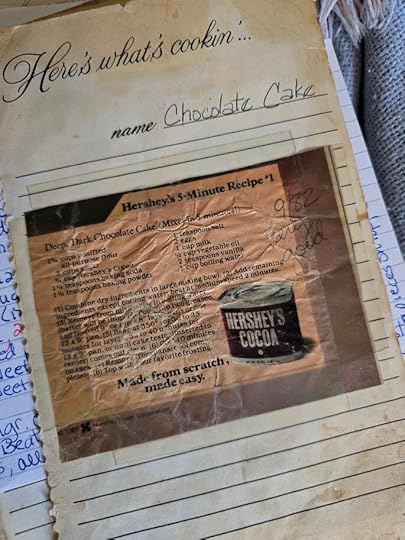 What I’ll Be Doing:
What I’ll Be Doing:In these next six weeks, I’m hoping to barrel ahead with Charlottesville.
At the same time — I know, I know — the holidays will roll over me, but that’s a good thing; I want to enjoy whatever comes my way. Secretly that includes some work on a middle-grade novel that I shelved this past spring and want to read and get back to. It’s a lot for a scant six weeks, eh? What about you?
I think we’re about to be thick into “the messy glory,” as Uncle Edisto calls it.
“Open your arms to Life! Let it strut into your heart in all its messy glory!”
I love that chaotic and loving family in Each Little Bird That Sings. Comfort’s story takes place from Easter to Thanksgiving Day. I’d like to read a story about how her family runs the town funeral home while navigating the holiday marathon. Maybe I’ll play with that this week. I’ll need to come up with some Southern holiday food and decorations and maybe it would be a prequel so Uncle Edisto and Great-great Aunt Florentine are still with us… and would Peach make an appearance? Would there be a funeral at Snowberger’s to cook for over the holidays? Let’s not run out of Snowberger handkerchiefs. Hmmm…
And what about you? What calls to you in these next six weeks? What is your messy glory going to be like, do you think? Or have you planned six weeks of utter solitude? I don’t believe you!
I would LOVE to hear from y’all about what the next six weeks might hold for you. Questions for you to answer, with my answers in parens:
What are your plans? ( Many !)
What are the wild cards? ( Charlottesville! )
What are the sure things? ( Dominoes! )
What are you making? ( Good Trouble, I hope .)
So that’s where I am right now, and where Storybelly is, at the end of this glorious and surprising inaugural year. It has been such a privilege! Truly. I appreciate you all so much. Thank you for your presence, your willingness, and your generosity this year.
I’m looking forward to the next few weeks of seeing y’all in Notes, on IG, in Chat, and to celebrating a first birthday for Storybelly in February — more on those plans after the holiday season.
I’m off to post in Notes and Chat. See you there — Happy Thanksgiving!
xox Debbie
November 17, 2025
Storybelly Digest: Origin Stories
Hey there, everyone! It’s good to be back at the Storybelly page. I’m deeply into my Charlottesville draft right now, and I’m finding it hard to tear myself away in order to attend to the pleasure that is Substack and the Writers Lab.
So today I’m going to send you to some links.
 The Links:
The Links:
I want to direct you to the very first Storybelly post — here, called “Introductions.” An origin story, sort of.
And here, written in December 2007, is an early post (the third one, I think) I ever wrote on my “Field Notes” blog at Blogger — here — called “I Got Married Today.” I was 18 on the day I chronicle. Another origin story.
Before “Field Notes” I wrote a blog for Harcourt, at their request, about The Aurora County All-Stars book tour, and you can find that (also at Blogger) — here, called “The ‘07 Book Tour,” although it started out as “One Pomegranate.” (Nancy Johnson will remember it that way!)
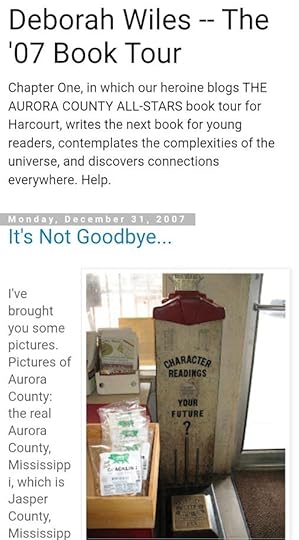
I loved this blog. It was the most authentic look at who I was, and was one of the first generation of blogs that came with photographs in 2007 — a brand new thing on the Web and a real delight at the time. I remember sitting on my bed at the Sir Francis Drake hotel in San Francisco, trying to figure out how to upload a photograph! THAT is an origin story as well.
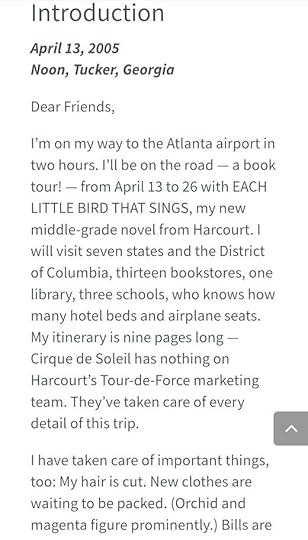
And before THAT, way back in 2005 — before there were blogs, but when Harcourt asked me to write about the Each Little Bird That Sings book tour from the road — you can read the daily account that Harcourt sent out to booksellers every day for two weeks — here, compiled and called The Each Little Bird That Sings Tour Journal, all text, no photos. And… an origin story.
 Ways of Telling
Ways of TellingIn various ways I have catalogued my life, just as we all do, in whatever ways work for us — ways that morph and change as we do over time. My Spotify song list is one way I’ve catalogued my life, as are the recipes I’ve saved over time, and the photographs that are way, way too disorganized, and that every year I say THIS will be the year I make photo album books for all of us. Sigh.
I catalogue my life in my books, too, even though they are fiction. I always say, “I take my life and turn it into stories,” and that is exactly what I do. Every one of my books has an origin story and is about a pivotal moment in my life.
CharlottesvilleRight now, I am facing the most challenging origin story of sorts, as I write about The Lost Cause of the Confederacy AND the Unite the Right rally in Charlottesville, Virginia in 2017. I grew up (as I often say) in the lap of the Lost Cause, and there is so much to share about that time, as well as The Lost Cause, period.
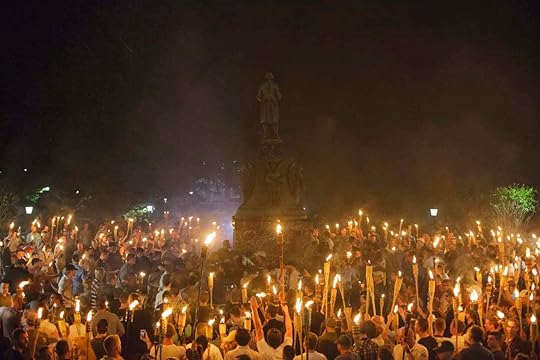 Alejandro Alvarez, News2Share,via Reuters
Alejandro Alvarez, News2Share,via ReutersWhen you combine that (because they belong together) with the Unite the Right rally — which I did not attend — well, I’m faced with an origin dilemma.
However, I was not at Kent State in 1970 and I wrote about that as well. I was adjacent to it, though, at a pivotal time in history and in my life — I write about my connection to Kent State in the backmatter of that book.
I’m bridging a lot of time with Charlottesville as well, which is why I’m using time folding in this book — a structure I’ve never attempted before, and which I hope I can pull off.
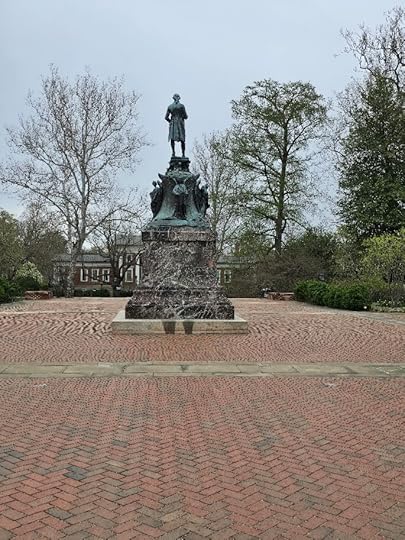
All to say that there are many different ways to write about your life, to catalogue your life, to learn about your life, your history, your biography… and it seems, when you are deep into it, that everything is research, everything is part of your origin story. We are always beginning again, eh?
ResearchI’ve catalogued lots of my research for Charlottesville both here at Storybelly in various posts, and at Pinterest where I have some Charlottesville boards. My current research is mostly structural at this point and includes:
There There by Tommy Orange
Homegoing by Yaa Gyasi
24 Hours in Charlottesville by Nora Neus
The Lincoln Highway by Amor Towles
AND the PBS “The American Revolution” series that started last night, another Ken Burns offering which will feature soon Thomas Jefferson, who is a player in my book, believe it or not. I almost can. :>
 Now, YOU:
Now, YOU:How are you cataloguing your own life? I would love to hear. You could make it your “Write it (or don’t)” this week, to think about ways of telling, ways of seeing, ways you make sure to say “I was here,” and leave that trail of breadcrumbs for whoever comes behind you, searching for meaning, for truth, for love. For proof of life! For kindness. For… what? What is your origin story?
Tell me. Tell me one of them at least!
What I’ve learned, in my quest for understanding, is that every origin story carries more than one truth: who we were then, and who we’re becoming now. And I’ve learned, too, that it takes real courage to do the hard work of change… and, sometimes, the equally hard work of enduring.
xoxox Debbie, heading back to it


November 11, 2025
Storybelly Digest: It Started With A Song
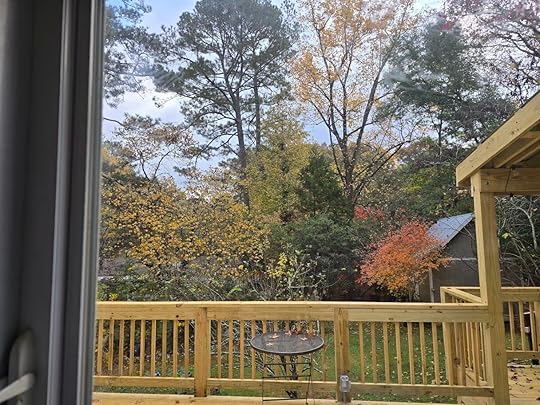 outside my kitchen window this morning
outside my kitchen window this morningMorning, everybody. Welcome to a story about how a song written in the 1980s by one person; turned into a poem written in the early 2000s by another person; turned into a revised poem that became a picturebook edited by two different editors at one publishing house; illustrated by yet another person came to be printed, bound, and put into readers’ hands a full 40 years after its original inception on a Thanksgiving day after Jim broke bread with good friends in Atlanta, Georgia, and long before anybody knew what they had on their hands.
This was the song Jim wrote, “Thanksgiving.”
I heard this song — and the story behind it — many years later, and fell in love with the song, the story, and the guy. I said, in just the way Jim had told me that my book One Wide Sky suggested music, that his song, “Thanksgiving,” suggested words. So I wrote some. This was what I wrote — you can play the music and read the words alongside it, to see how I was parsing the lines to go with the music:
Thanksgiving
The clouds above surround our world
and wrap us in their arms
The rain that falls upon our shoulders
blesses fields and farms
The earth beneath our feet spins ‘round
and rivers ‘cross it run
The day awakes, I see your face,
bright shining as the sun!
It’s me again (the clouds)
It’s you again (the rain)
It’s us again (the earth)
Come ‘round again.
Love connects us every one,
The world is one.
I hear the song that nature sings
that links each heart to mine
The ocean blue, the sky above,
the forest with its pine
We laugh, we cry, we share our lives,
we watch this play divine
The earth, the wind, the waves, the sun
we all are intertwined!
It’s me again (the sea)
It’s you again (the woods)
It’s us again (the wind)
Come ‘round again.
Love connects us every one,
The world is one.
The sun will set, the day will sleep,
the moon will breathe goodnight
To all the children of the earth
and everything in sight
We’re different yet we’re all the same,
we’re loving, brave, and bright
Like blades of grass or mountains grand
a visual delight!
It’s me again (the sun)
It’s you again (the moon)
It’s us again (all things!)
We’re home again,
Love connects us every one,
The world is one.
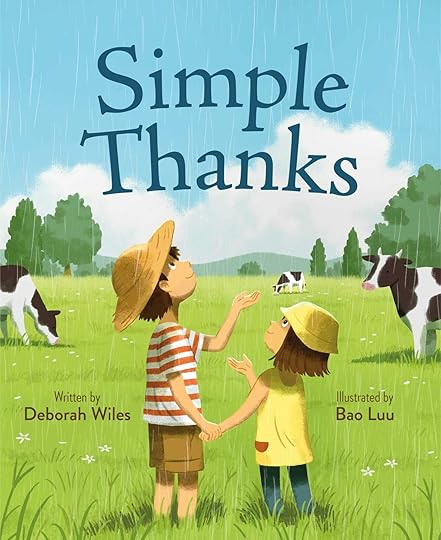
I loved the poem so much, I sent it to my agent, hoping we might sell it as a picturebook. I sent him Jim’s music as well. He warned me that the publishing industry wasn’t “into” coupling music with words — and this was back in the day when the publishing industry wasn’t seeing the value in “comic books” that turned into graphic novels. So I decided to keep trying.
I had a vision for the book and music together, the same way I’d had a vision for One Wide Sky with its music, so I held onto that as the manuscript made its rounds.
Unfortunately, my agent was right, the publishing world wasn’t into packaging a CD with a book, or even putting in the backmatter a link to the music. They also weren’t into buying my book. And this was at a time when self-publishing was mostly vanity presses, and in addition I was no artist so would need to find someone to illustrate my words…
The Book:Here’s where the right-time, right-place comes in. I pulled the ms from consideration and held onto it for years. My agent and I brought up from time to time in book discussions, market discussions, possibility discussions. I think we sent out the ms, almost to test the waters, a time or two more. One year grew into ten. I wrote other things.
And then one day my agent called to say there was an editor at Roaring Brook, Kate Jacobs, who was looking for a book about gratitude, and he thought of my Thanksgiving ms. I sent him a fresh copy, he sent it to Kate, and Kate made an offer to buy the book. But she wanted revisions. I said okay.
My idea was a book about the universality of morning/noon/night and the experiences we all have as human beings on this planet… how we are more alike than we are different and how gratitude can bring us together. These are lofty concepts (or at best abstract) to impart to a young child.
Kate’s idea made sense, to bring the book onto a parent’s lap with a child and let them connect closely to the day and the world around them using plain language and objects children would know, while keeping the universal feel of the story, and perhaps while losing a bit of the parsing, because now I would not be writing to a song. A song is not a picturebook. Sigh.
And I said yes, I would try. I delivered a revision — maybe a couple of revisions — and that’s what you have in your hands, if you have the finished book. You can see the changes we made to make it as accessible as possible. It doesn’t parse with the exact notes of the song anymore, but it does better suit a young child’s sensibilities so they can connect with it, and that’s the point, yes?
Then Kate Jacobs was laid off, like so many were in publishing shake-ups during the pandemic, and Mekisha Telfer inherited Thanksgiving, which became Simple Thanks. All of this took a while to shuffle and settle including the time it took Bao Luu to illustrate the book, of course. Bao was one of three we were looking at to illustrate, and my top choice. My only notes on illustration were that I was hoping for a book that helped all children see themselves and the natural world and know how amazing was the living of every day.
And in that, Bao delivered. I had a book I was proud of, and that many people had had a hand in making.
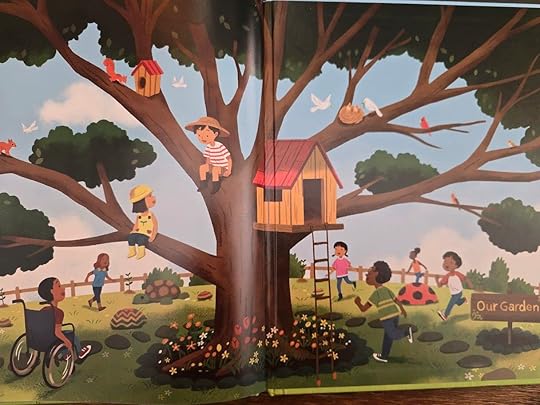
I wanted to include the first stanza of the hymn “For the Beauty of the Earth” in the frontispiece, and we did that, too.
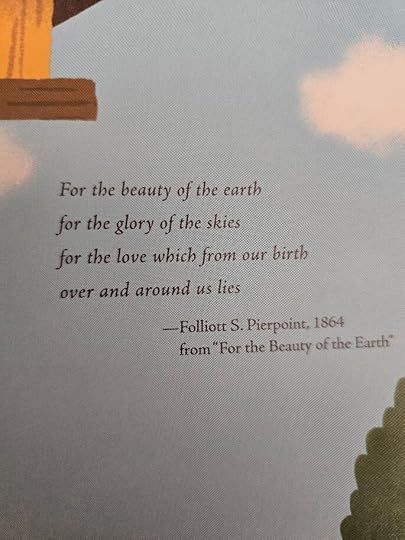
I had championed the music to no avail, so I knew that the music, if I wanted to use it, would have to come separately, in the way that Jim’s music for One Wide Sky was on CDs that I took to schools and left with teachers after I presented the book and we had learned it and sung it and danced to it. Which is what I did with One Wide Sky and its successor, We Are All Under One Wide Sky.
The Music:Jim had recorded the tune on his first record album (which we call The Red Album) years before he and I met again. “I was living alone in my late 20s, and I went to Thanksgiving dinner with two really kind old people, lol, and when I got home I felt inspired, and wrote this tune. I put it on the Red Album, had 500 copies of that album made. It had no distribution and it became immediately obsolete because CDs came along right at that time, and nobody was buying a vinyl album.”
For a long, long time, that was the only way to hear “Thanksgiving” outside of gigs where Jim might play the tune for the offertory at his steady church gig or as part of prelude music before the wedding march as people were getting settled in their seats.
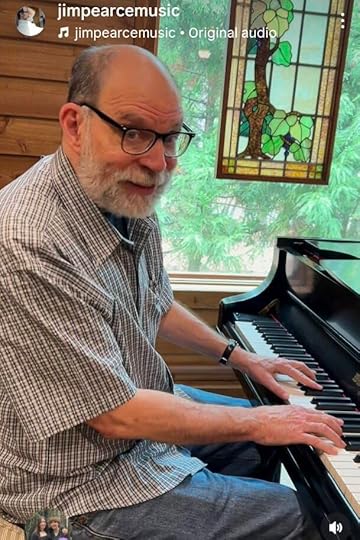
On Oct. 6 this year, Jim played the song for us: you can watch him play it here, on his IG account and you can read along with the finished book to see how the music still fits the tone, the intention, and the words. Many stanzas have stayed the same, actually… we just made some concrete tweaks and here are some of them:
Which version do you love most? :> One thing (among many), and maybe the most important point I wanted to make with this book, was this phrase:
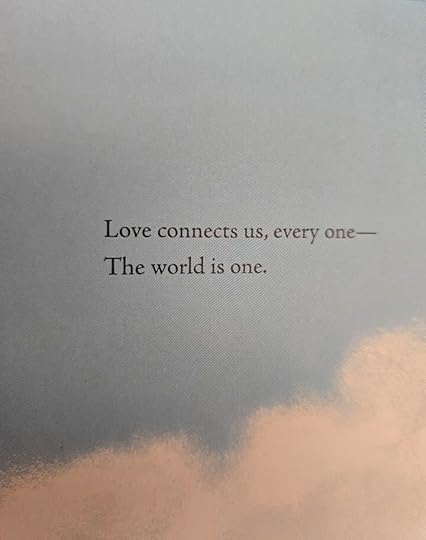
One of my deepest held beliefs.
All to say, don’t give up! Times change, people change, circumstances change, and it’s a wild ride sometimes, or at the least, a long one. Today we have many more roads to publication as well that are worth investigating, as many of you are.
We tell our stories and share them in so many ways, and that’s the important part. We never know where a gathering will go, where a song will go, where a poem will go, or who will listen to our song, read our poem, open our book, tell our story. That’s the beauty of paying attention, asking questions, and making connections in order to say we were here, and are here, and have stories to share.
And with that, I leave you on a frosty November day here in Atlanta. American Thanksgiving is two and a half weeks away and, 45 years after a lonely young man found inspiration at a Thanksgiving table with “two kind old people,” I can see the trajectory of that moment folding into this one, with a book in my hand that shares with youngest readers a story (and a song) about the art of appreciating the most simple gifts the earth gives freely to all of us, every day.
Have a good week, everybody.
xo Debbie
November 7, 2025
Writers Lab: Everything's Coming up Stories
Morning, Lab Coats! Two short days from now — on November 9 at 11amET — is our Second Sunday Live! Let’s meet for 90 minutes this week, if you’ve got that much time. We have so much to do:
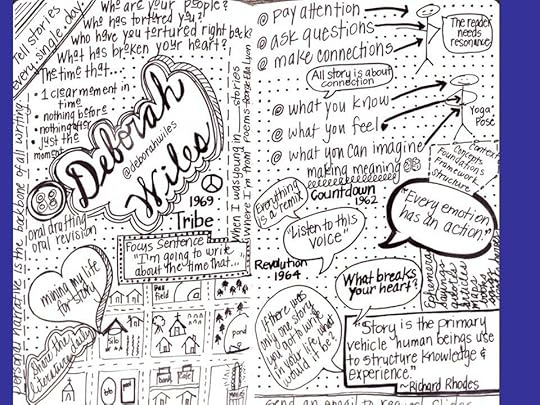
There’s welcoming all faces new and old (you know what I mean) — so gratifying!
There’s Jennifer’s Storybelly Book Launch — hooray!
There’s our Zine Project to discuss — fabulous!
There’s Writing Together — a must! (because we love the synergy so much)
There’s Sharing and Talking about Next Steps — essential!
All of it will take place in our 90-minute time frame. We can do it. We always do.
","alt":"","staticGalleryImage":{"type":"image/png","src":"https://substack-post-media.s3.amazon...A note for all Storybelly subscribers: Monday’s Digest is always free for everyone and full of good stuff about books, writing, and life — home & history. Beyond the weekly Digest, if you’re looking for some writing inspiration, this is a good time to join us in the Writers Lab.
If you’re searching for a supportive community of down-to-earth, humble and hilarious creative wonders, you’ve found us. We’re writing and making and composing and sharing all sorts of different projects, some “assigned,” and some spontaneous creations.
Our Lab Superpower is our enthusiastic willingness to suit up and show up for ourselves and for one another, and to co-create this space. We’ll welcome you with open virtual arms. And hearts.
You can join us here on a monthly or yearly basis. All projects and efforts (including Zine work) are ongoing, so you haven’t missed anything. You can jump in anytime, anywhere you feel most pulled to participate or study.
Start with reading Lab Posts, do the assignments if you’d like to, share your thoughts in comments and your work in Chat if you’d like — we’ve got you and we’ll join in.
The Lab is the only paid portion of Storybelly for a reason: we’re creating a safe and convivial space to share our stories. It’s a great place to park yourself for a little me-time, some creative-time, every week. We’ve got a depth and breadth of experience you can tap into (and you can share yours with us) in the Lab, in all genres, encompassing all goals, from creating a family legacy to indie and traditional publication.
Onward, Lab Coats. Here are the deets for this Sunday’s Live!
November 4, 2025
Storybelly Digest: Simple Thanks
Morning, everybody! NOVEMBER, right? The month of gratitude. I’m going to be talking about picturebooks on the ‘belly this November, starting with my newest book, Simple Thanks. I’ll tell you about the long journey to a home with this book (okay, I’ll tell the short version), and about how it started with a song written by Jim Pearce. (link to Jim’s Instagram page)
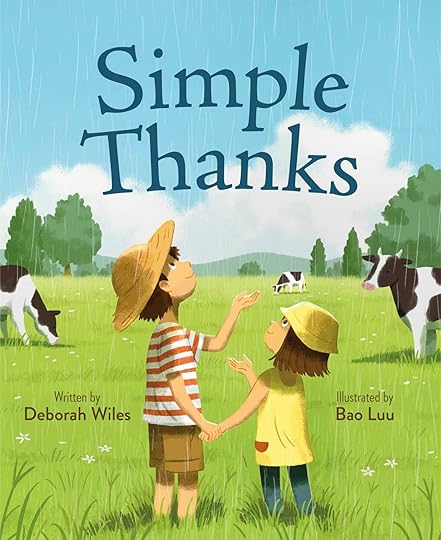
The tune Jim wrote is called simply “Thanksgiving.” He wrote this tune after a particular Thanksgiving dinner and recorded it for “The Red Album” (an actual vinyl record album!) long before we met again. I wrote the words to Jim’s music years later.
Then there was a… winding… path to publication. A long and winding road. :>
I want to do right by this story, so I’m going to save it for next week’s Digest. For this week, for some context, I want to share the interview that Cyn Smith did with me titled:
And I’ll share Jim’s music at Spotify. We don’t have a recording of “Thanksgiving” yet; it exists only on The Red Album. It’s on the to-do list. (Jim says maybe he has a piano version recorded but not published; stay tuned.)
These things are all connected over years’ time! The way years and connections thread through a life fascinates me — and maybe you have these stories, too? —so that’s something I’ll talk about this month. Maybe it’s something you’ll write about, too… you could consider that your Storybelly prompt for the week, if you like.
IT’S ALL ABOUT CONNECTIONS:Remember my insistence that all writing is about “what you know, what you feel, and what you can imagine,” which coordinates with “pay attention, ask questions, and make connections.”
For this week I’ll be thinking/writing about Jim’s composition of “Thanksgiving” and recording the tune probably 35 years ago; his long career as a working musician; our chance meeting again; my words to go with his tune; how long it took for Simple Thanks to find a home; and that long-time career as a musician for him, as a writer for me….
Basically this is a story about continuing to create a Writing Life (whether it’s in words or music), complete with its ups and downs, its recastings and repurposings, and the quiet recommitment it takes to keep going.
I was glad to read this interview again myself, as I’ve struggled with that sustained recommitment since the pandemic sent me home from a lead-title national book tour in 2020. I talk about this in the interview as well.
It all takes the time it takes, yeah? That’s what I’m thinking about these days. I know I’m not the only one who has struggled. I’ll say more in the comments.
Meanwhile, here is the Cyn Smith interview. The entire website is a rich resource and a real service to anyone who wants to write, so do take the time to surf around there, and gather some inspiration.
Cyn is also a long-time published author, and you can read more about her and her wonderful books — and her work bringing Indigenous stories, authors, and illustrators to young readers — here: Cynthia Leitich Smith.
Near the end of her interview with me, Cyn asks me:
As a writer, what do you wish for yourself in the future?
And here is my answer:
I would like to have the time to write what’s on my heart to write. I’d like to find like-minded people – writers, readers, editors, publishers, partners – to share the road with.
I feel like Storybelly has come into my life as part of that answer as well.
SO, WITH THANKS:In this month of gratitude, I want to thank all of you.
Thanks as ever for hanging out here with me each week, for sharing the road, for lightening the load, and for writing your own stories, whether they are written on your own, or written and shared in the Writers Lab.
My fondest wish is that we would all tell our stories, whatever they may be. As I always say when teaching in workshop or speaking from a podium — or as a reminder to myself when frustrated with this or that:
“It’s hard to hate someone when you know their story.”
xoxo Debbie
Pee Ess (thank you, Ruby Lavender): When finding links for Simple Thanks today, I noticed that the book is 59% off at Amazon right now — wow, that makes it $7.82 for the hardcover, and cheaper than the Kindle version. If you grab it there or at your local library as an ebook, you can follow along next week with the story of how it came to be and the changes we made for publication. (It is not necessary to have the book to-hand for this, just mentioning it in case you want to see the way we worked from tune to song to story, or if you might like to gift the book this Thanks Giving season.) xoxo

October 31, 2025
Writers Lab: Notes on Progress
Good morning, Lab Coats, you Sweethearts of the Storybelly Lab. How is it Friday already? Happy Halloween! The homemade, unfettered, bare-bones (ha) Halloween of my childhood (and my children’s childhood) is my favorite holiday.
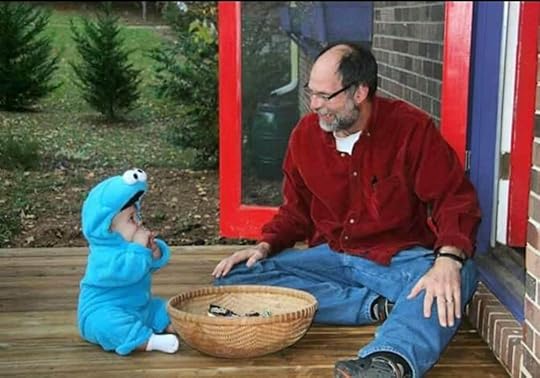 Continuing simple traditions, grandgirl #3’s first Halloween, trick-or-treating at Grandpa’s house. She is 14 years old today.
Continuing simple traditions, grandgirl #3’s first Halloween, trick-or-treating at Grandpa’s house. She is 14 years old today.I’m going to plunge right in to this week’s Lab so the paywall is high up this week (and some weeks it’s all paywalled) so we can get right down to business.
“Business.” hmm. “Creativity” is more like it. So we can get right down to creativity.
But an announcement for everyone first, to say that our November “Second Sunday Live!” is happening on Nov. 9 at 11amET when we will have the pleasure of a Lab Coat sharing with us her New Book! I’m so excited and chuffed and delighted to help launch Jennifer’s new book (link is to book trailer).
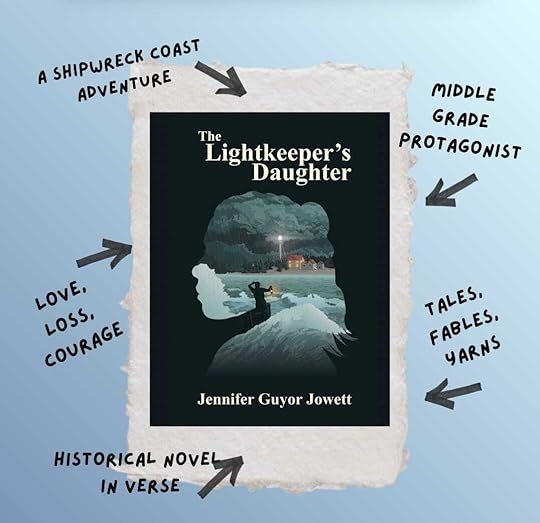
If you are not yet a Lab Coat and want to be part of the fun (the writing, the sharing, the laughing, the music, the stories!), come join us in a fabulous writing community at Substack.
And now, some Zine catch-up stuff (Zines are arriving, and they are fabulous!); some encouragement and inspiration for same (including for me; I am slowly getting there); and the Google Meet link for Nov. 9’s Live.
Also: A Weekend Prompt for Zine-Makers, Dreamers, and Tinkerers:
October 27, 2025
Storybelly Digest: The Most Dangerous Day
Evening, all. I hope your week is off to a good start! Here is the last entry in our month about Countdown.

October 27, 1962, was the most dangerous day of the Cuban Missile Crisis, as events rapidly escalated and brought the world to the brink of nuclear war.
Shooting down of the U-2 spy plane:
On this day, a U.S. U-2 spy plane flying over Cuba was shot down by a Soviet surface-to-air missile, killing the pilot, Major Rudolf Anderson.
Nuclear submarine incident:
Also on this day, a Soviet submarine B-59 was located by U.S. destroyers involved in the Cuban boycott and was threatened by U.S. depth charges. The submarine’s captain ordered the launch of a nuclear torpedo. The second-in-command, Vasily Arkhipov, refused to give his consent, and war was narrowly avoided.
The secret deal:
At the end of this day in 1962, a secret deal was reached between the U.S. and the Soviets.
The Soviet Union would remove its missiles from Cuba under United Nations supervision.
The United States would publicly pledge not to invade Cuba.
Secretly, the U.S. also agreed to remove its Jupiter missiles from Turkey.
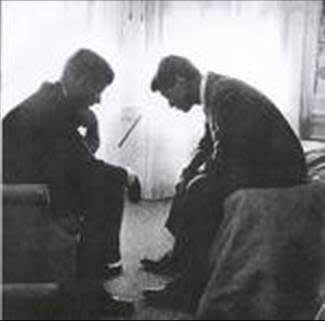 President John F. Kennedy conferring with his attorney general, his brother, Robert F. Kennedy, Sr., October 1962
President John F. Kennedy conferring with his attorney general, his brother, Robert F. Kennedy, Sr., October 1962

In Countdown, I’m giving the reader context for the history behind the Cuban Missile Crisis in the scrapbooks of songs, photographs, newspaper clippings, and other archival material and cultural ephemera of the early sixties.
Then there is the story of Franny and her family navigating those fourteen days when the world came as close to annihilation as we’ve ever been — or as close as we know about, anyway.
I use a Halloween party and its dangerous aftermath on October 27 to mirror those last days of the Cuban Missile Crisis in October 1962. The story comes to a head at the gravel pit, just as it did on October 27 in Washington, DC, although in Countdown, our characters find themselves in the woods on the way home after the party, where Franny fears she herself may never see another Saturday night.
After a fight, a swing over the gravel pit, a fall, a daring rescue, a broken collarbone, a well-trained dog, and — finally — the sure knowledge that all is well and everyone is okay, I want my characters — and readers — to feel the relief of not only their adventure resolved, but of the world going on.
So I chose to end my story on Halloween night, 1962.
This is the ending to Countdown:
Jack, who has been busy with trick-or-treaters, comes bounding across the yard, so happy to see Margie. It takes two seconds for him to find the scarves, pick them up, and bring them to her. She buries her face in his shaggy body. “Good dog, Jack. Thank you.”
My hard heart begins to melt and I hate that. I have every right to hate Margie Gardener forever.
Margie sniffs and say, “Well, I’ve got to get dressed for trick-or-treat. The girls are both Tweety Bird.” She looks at me one last time, as if she thinks I might respond. When I don’t, she turns slowly and walks away.
My gut begins to churn.
“Hey!” I call after her.
She spins around to face me, hope washing all over her face. I hate that, too. But there’s something about it that helps me find some words.
I take a deep breath. “Maybe.”
“What?”
“Maybe… I’ll see you tomorrow.”
Margie nods. “Tomorrow.”
I watch her until she’s out of sight, then I take the scarf-rope from Jack and walk back to the card table in the soft October dark.
“Could you tie this around my sling, Uncle Otts?”
“Let me see,” he says.
And, while Uncle Otts ties a snug knot, it comes to me that I will go on to grow up now — I feel it. I will grow old, like Uncle Otts, with all kinds of stories to tell, all kinds of days to remember, all kinds of moments I will live, and choices I will make.
Like Jo Ellen said: There are always scary things happening in the world. There are always wonderful things happening. And it’s up to you to decide how you’re going to approach the world… how you’re going to live in it, and what you’re going to do.
Now I get it. Now I see what Jo Ellen was talking about. Now I understand what Margie wants, what Uncle Otts was searching for, why Chairman Khrushchev and President Kennedy finally listened, how no one wants the world to blow up, and why my family and my friends are mine to love, no matter what calamity befalls us.
It’s not the calamity that’s the hard part. It’s figuring out how to love one another through it — that’s the hard part. Or maybe that’s the easy part. I don’t know yet.
I’ve got a lifetime to figure it out.
It’s good to be alive.
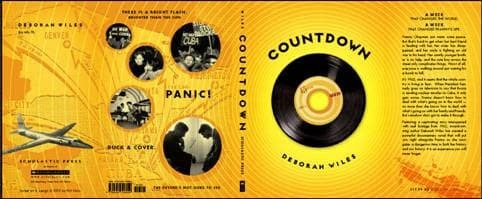

Well…. Halloween! It was my favorite holiday as a kid, and as I raised kids. It was non-commercialized, homemade, rough-around-the-edges, and full of good cheer.
A woman in our neighborhood in Camp Springs (the same setting as Countdown) dressed as a witch and sat at a card table in the sifty dark at the end of a walkway that ended at her front door. The candy was on the card table.
She didn’t scare us. She didn’t say a word and we couldn’t see her face. It was THRILLING to make the walk up that long sidewalk, trembling with imagined fear, snatch a treat from the table, and run screaming into the dark.
When I had kids, we made a fire at the end of the driveway in Frederick, Maryland, under an old silver maple tree. We brought out the hot dogs and chili, the lawn chairs, the scary music (from a cassette tape in a boom box, no less), and decorated the yard with homemade tombstones or dead guys in clothes stuffed with newspaper.
The leaves crunched underfoot and the fire was cozy; everyone stopped on their way from house to house, parents sitting for a few minutes in lawn chairs and sipping cider or having a bowl of chili with cheese and Fritos on top, kids racing around the yard or to the house across the street, or, more likely, sprawling on the living room rug and trading candy.
My elder son, Jason, still makes a fire at the end of his driveway for his daughter and friends. I love to go there and continue the tradition… a tradition I gave to Franny’s family in Countdown as well.
Taking my life and turning it into stories. It’s what we do, eh?
Have a safe Halloween! See you next week.
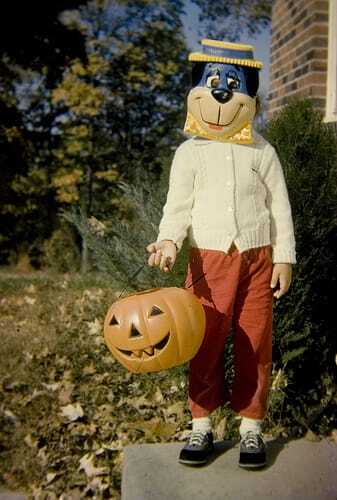
PEE ESS:
If you are a Lab Coat, just a note to remember our next Live! on the Second Sunday in November, Nov. 9. 11amET. Watch for more about this in Friday’s Writers Lab.

Write about a Halloween you remember…
“The time that” is how to approach it… start your Focus Sentence with that phrase.
Write about One clear moment in time. Nothing before that moment on that Halloween, and nothing after.
Use as much description as you like. Try some dialogue. And a surprise!
xoxo Debbie
October 25, 2025
Writers Lab: What Helps
Morning, Lab Coats. Debbie here, spent from a busy week, working through a long Saturday list already, missing you guys on a Sunday morning, thinking about Zines, hoping you’re doing well. I want to offer some resources and ways of working with our hands and making things… making something always makes me feel better… you?
Whether it’s picking up the guitar to riff a while or scratching some words in a notebook; digging in the dirt, mixing a cake, organizing a room, folding and cutting paper to make a little artifact that says, “I was here”… there is enough gloom and doom to go around, eh? Let’s make something. To wit:
Our Zine Project:How’s it going in your neck of the woods/city/stoop?
I’m sending this just to Lab Coats this week (i.e. no verbiage for everyone before the paywall), in hopes you might use the comments here to talk about what’s happening in your Zine world, to ask questions, to offer some support or encouragement, to say where you are right now with the project, and to t…
October 20, 2025
Storybelly Digest: The Missiles & Missives of October

In 2008 we enclosed our carport here in Atlanta, in order to give ourselves a place for a kitchen table and a gathering room. We named our new room “Irene.” No one remembers exactly why or how, but the name has stuck. Our first “event” was a gathering for our youngest child’s college graduation. Her best friend Irene came from our old home place near Washington, DC, so maybe there was something in the air with that name, who knows. We invited the neighborhood and had a pot luck.
For the past seventeen years we have hosted countless domino games, Sunday dinners, parties, musical and wedding events, all with our near and dear, and all while creating a history as we figured out how to live in a new way, in a new place.
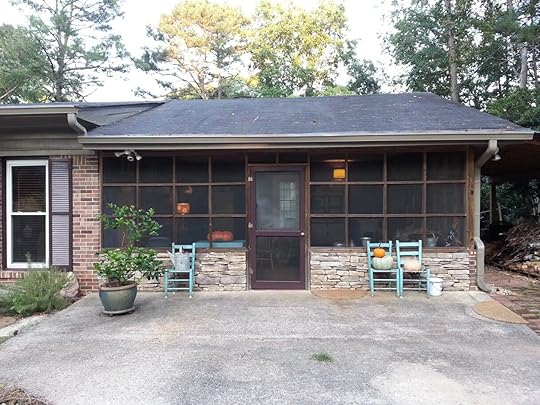 Irene’s original incarnation
Irene’s original incarnationThis fall we gave Irene a facelift. We removed the (beloved) screens and installed windows and an exterior door. I indulged in a wood stove — something I’ve been wanting to add, all those seventeen years.
I had nightmares as we ordered windows, the door, the wood stove, and wrote checks for same. Were we (okay, was I) making a mistake? Irene had become a one-season room — or two, if you count them as shoulder seasons: the weeks between spring and summer and the weeks between fall and winter. Otherwise, it was too hot (even with fans), too cold (even with a heater), or too full of pollen, which is a long, thick season here in the South.
It was a good idea in theory. Then the contractors arrived, and I knew it was right not just in theory, but in fact.
I’m slowly washing everything and putting it in its rightful home as I reconsider and change-up old systems and organization. I made a fire in the wood stove this morning and came out here to the little table in Irene (our old table is now on the (newly replaced) back deck, but that’s another story).
I’ve been thinking a lot about homes and rooms and the history they hold.

Today, October 20, in 1962, is the day that President Kennedy declared the US would create a blockade around Cuba, in an effort to bring the Soviet Union to the bargaining table and stand down from the buildup of nuclear weapons.
On October 22, 1962, JFK addressed the nation and told the American people for the first time what had been burbling in security meetings, in secret, as the US came up with a strategy for dealing with the missiles in Cuba.
You can read a straightforward accounting of the Cuban Missile Crisis on this fascinating page at the JFK Library. You can read JFK’s Oct. 22 speech there, too.
Here is how I handled JFK’s speech to the nation in Countdown. Keep in mind as you read it, that this scene wasn’t in the original draft of the book. I wrote it at the request of my editor, David Levithan, who said, “We need to see the speech, and the reaction of Franny and her family to the speech — it’s a pivot point!” It was indeed, in real life, and in Countdown’s plot:
We are glued to the television as a family, at seven o’clock. Mom and Dad sit on the couch. Uncle Otts is in his chair. Drew and I are with Jack, on the floor, in our pajamas and slippers, in the same positions we take when we watch Walt Disney’s Wonderful World of Color on Sunday nights, only there is no Tinker Bell, no Walt Disney, no thrilling opening music.
But there is President Kennedy, and he is so handsome, almost as handsome as Daddy. He’s sitting behind his desk and he looks very serious. He doesn’t smile or show his teeth. John-John and Caroline aren’t there with him, and neither is Jackie — Mrs. Kennedy, the First Lady — who Mom says is class personified. It’s just President Kennedy, the American flag, and us.
Good evening, my fellow citizens.
Mom whispers, “Look at the dark circles under his eyes.”
“He hasn’t slept for days!” snaps Uncle Otts.
“Shhh!” says Daddy.
Drew clutches his book while President Kennedy tells us shocking news. The Russians have been secretly shipping atomic missiles to Cuba, and we, the American people, need to know about it.
Each of these missiles, in short, is capable of striking Washington, D.C…
As if on cue, thunder claps outside our windows, and we all jump. Even Jack whimpers.
In addition, jet bombers, capable of carrying nuclear weapons, are now being uncrated and assembled in Cuba…
Russian jets and Russian missiles in Cuba, with Russian bombs aimed at us, right at Washington, D.C. Uncle Otts was right.
I call upon Chairman Khrushchev to halt and eliminate this clandestine, reckless, and provocative threat to world peace…
In fact, the bombs can reach the whole world, says President Kennedy. He wants Chairman Khrushchev to stop trying to take over the world. We are the United States, and we will not surrender. We’re going to make blockades in the sea and we will fight back if anyone in the world is attacked.
The cost of freedom is always high, but Americans have always paid it. And one path we shall never choose, and that is the path of surrender or submission.
Jo Ellen was wrong. The Russians are coming to get us — they’re practically next door. My slippered feet are like ice and my mouth is as dry as a cotton ball — I don’t even have any spit to swallow. I look at Drew, but he won’t look at me.
There are no commercials after President Kennedy’s speech, just Walter Cronkite, to tell us what we already heard. We might be at war with the Russians any minute. Any minute, those bombs might come roaring our way. We need to be prepared. We need to stay safe. And that’s the way it is, Monday, October 22, 1962.
I loved writing this scene, and I loved the research that went into it.
This was going to be my end of chapter 24, but it wasn’t “finished” yet. Like call-and-response, I couldn’t just leave my family there and pick up with chapter 25 the next morning. What was everyone’s reaction? Can I create enough tension to help the reader care about these characters in this pivotal moment?
So I wrote on for a few pages until we reached a satisfying ending . Now, at the end of chapter 24, after this big reveal of the missiles in Cuba, we see how each family member reacts to JFK’s speech. I end the chapter with eleven-year-old Franny because she is my point-of-view character:
“Do you still say your prayers? Uncle Otts asks me as we climb the stairs.
“Yessir.” I get on my knees beside my bed and say the usual.
The rain sluices down my windows in the darkness. Thunder rumbles and crackles. Uncle Otts turns out my bedside lamp, tucks the covers around me, and kisses me on the forehead. I can feel his whiskers and smell his spicy smell. By the glow of my night-light, Uncle Otts says, “There was a time — I wasn’t much older than you are now — when I was sure it was the end of the world.”
“Were you afraid?” I ask him.
“Oh, yes,” says Uncle Otts. “Very afraid.”
“What happened?”
“I grew up to become an old man,” says Uncle Otts. “That’s what happened. And that’s what will happen to you, too.”
I think about this. “I’m not a boy,” I say.
“Then you’ll become an old woman,” says Uncle Otts.
I can’t imagine being as old as Miss Mattie, as old as Mrs. Rodriguez, or as old as Uncle Otts. That’s old.
“Are you sure?” I ask him.
“Very sure,” he says. “Now go to sleep.”
We stay with Franny and her thoughts for another couple of paragraphs, and then I close by inserting a new scrapbook for context before beginning Chapter 25. Now the reader is grounded in the story, the history, and the emotional beats I want them to have.
This is the beauty of revision… and the gift of having an invested reader who can point out to you what you have missed, and where you can improve.

A quick note about the Writers Lab this week. We had an amazing Second Sunday Live! in October. We wrote about home and then shared what we’d written and were so chuffed at our brilliance (hee, really) that we decided to Zine-It-Up and make a series of Zines with our stories as the stars, in order to celebrate and save the story of that Sunday Live. Our own little Nutshell Library.
We’re working on that project now. As always, I offer an invitation to everyone to join us in the Lab where we are storytellers of every kind and all are welcome. You can join us here.


I’m proud of the publishing partners who helped give birth to these books, to the teams that have helped them find readers, and I am grateful for every reader who opens these books and sees a bit of history and home, community and compassion. I hope readers connect to their own place in history and home when they read my books. You can find out more about each book, and you can buy them, too, at my website.

Pull out a photo of home, or what home means to you; pull it up in your imagination if you aren’t into photos. Write for 20 minutes about “the time that.” You can post it in comments, or if you are a Lab Coat and you missed the Second Sunday Live!, you can send it to me in Chat for inclusion in our Zine project.
Here is Zak Foster showing us “How to Fold Your Brand-New Zine” — you’ll find more directions from me in Chat.
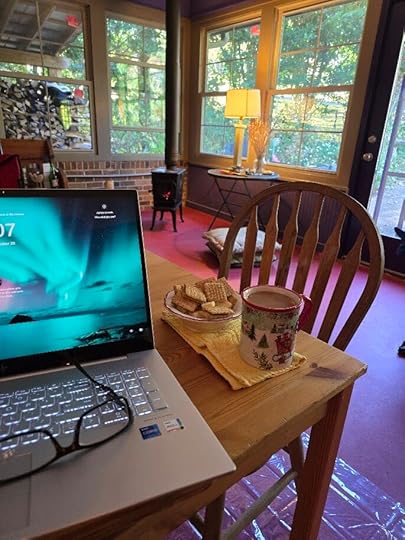
I’m writing this from Irene, fire crackling, thinking about the rooms we build — and rebuild — to hold our memories, to comfort our hearts, and to keep one another safe. Whether those are actual rooms or rooms we write about in fiction, home and history both need tending.
Thanks-ever to everyone for reading and hanging with me, here at the ‘belly… another kind of room full of stories. Have a great week!
xoxo Debbie



